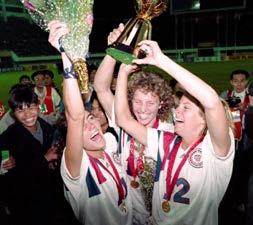
4 minute read
Generation Zero

A UniÞed Theory of How We Got Here
Baseball has the 19th century National League. Basketball traces its roots back to Dr. John Naismith Generation and his peach baskets. With Generation Zero, the new popular history from author and MYSA alumnus Hal Phillips, American soccer Þnally has a Creation story of its own Ñ a modern one, beÞtting the game’s extraordinary growth since 1970.
Released in July 2022, Generation Zero: ZeroFounding Fathers, Hidden Histories & The Making of Soccer in America (Dickinson-Moses Press) is today the bestselling soccer title on Amazon. It’s available for purchase there, at Barnes&Noble.com and Þner independent bookstores everywhere. With a World Cup upon us, with the tournament spilling over into the holiday season, this exuberant tale (much of it set here, in the author’s native Massachusetts) might just be the perfect holiday gift for all the parents, players, coaches, referees and club volunteers on your list. “U.S. soccer fans of a certain age all remember growing up in a famously soccer-indifferent nation,” says Phillips. “Today, we live in a completely different America, thanks to Generation Zero — this cohort of boys and girls born in the 1960s and raised on futbol in the ‘70s, during the Youth Soccer Revolution.” Generation Zero is Phillips’ narrative shorthand for Generation X, the cohort of Americans (born 1961-1981) that Þnally produced both ends of soccer’s formative equation in the U.S.: national teams good enough to compete on the world stage and an audience that would care, the country's Þrst legitimate futbol fan base. The author also asserts that everything we associate with today’s rich American soccer culture was enabled by the U.S. Men’s National Team that qualiÞed for World Cup 1990 Ñ and the newly formed Women’s National Team that claimed the Þrst world championship ever held, in 1991. “World Cup participation was the key, because pro soccer didn’t exist here once the North American Soccer League folded in 1984,” Phillips says. “And here’s where the GZ narrative connects: Every member of those pivotal national teams participated in the Youth Soccer Revolution during the 1970s. During the century prior, outside a few immigrant enclaves, soccer had never been a game played by suburban boys and girls — not as kids, not in such overwhelming numbers. “That lit the fuse — because those same boys Julie Foudy, Michelle Akers and Carin Jennings celebrate and girls grew up! As adults, their fan support for the 1991 women’s world title, the first ever contested. U.S. national teams, men’s and women’s, starting
The 1989
USMNT, just minutes after securing its first World
Cup berth since 1950. That’s a young Andrés Cantor at left, interviewing
Tab Ramos.
This book is chock full of rare images from official USMNT photographer Jon van Woerden, including this one, and the cover shot.

in 1990, proved critical. Their attendance and viewing habits made a success of World Cup ‘94, then MLS, and now the NWSL. And just go ahead and state the obvious: The game of soccer, in all these forms, is everywhere on TV in the 21st century. It’s stunning how far it’s come.”
Nothing happened overnight, however. These pivotal moments in 1989, 1990 and 1991 were two decades in the making. Generation Zero details that evolution as no book ever has: from the default reign of largely clueless Soccer Dads during the Seventies, to the critical launch of the Olympic Development Program (1978); from the Carter-era heyday of NASL to its sad demise in 1984 — just as future members of the 1990 USMNT were poised to make their professional careers therein.
The 1980s did indeed foist upon Generation Zero one futbol indignity after another. The dearly departed NASL would not be replaced for 12 long years. Soccer on TV? Only the indoor variety could be found there — late at night, on content-starved cable outlets, right after competitive lumberjacking. When the U.S. failed to qualify for its 9th straight World Cup, in May 1985, soccer’s domestic critics danced on its grave. However, these failures moved the U.S. Soccer Federation to drop the entire senior national team program in the lap of Generation Zero, half of whom were still in college — none of whom had anywhere to play professional club soccer. Phillips spoke to a dozen different national team players for this book, and he did so from a unique vantage point: He is exactly the same age as these primary sources. In fact, he competed against them during youth tournaments, at college, in the urban/ ethnic leagues that topped the American soccer pyramid during the post-NASL apocalypse.
“The personal couldn’t be avoided,” says Phillips, who grew up in Wellesley and played soccer at Wesleyan University, then in the semi-pro LASA League during the late ‘80s. “I mean, [USMNT striker] Bruce Murray did billet in my house, back in 1976. I grew up with women’s national team pioneer Lauren Gregg. These are legends, but we all lived through the same period — and I was determined to paint a nuanced portrait of those two decades. The 1970s were so rich, so eclectic, so detached from convention: I don’t think soccer would have gained such a cultural toe-hold, for example, had that decade been more effectively tied to traditions and uniformly held ideals of community and sport.” As for the late ‘80s, the author defers to 3-time World Cupper Marcelo Balboa: “We wanted to leave something behind, a legacy — and I think it was the mullet. We tore it up on the mullet front.”






